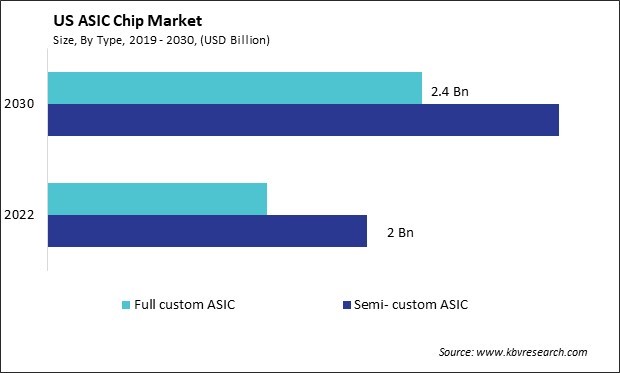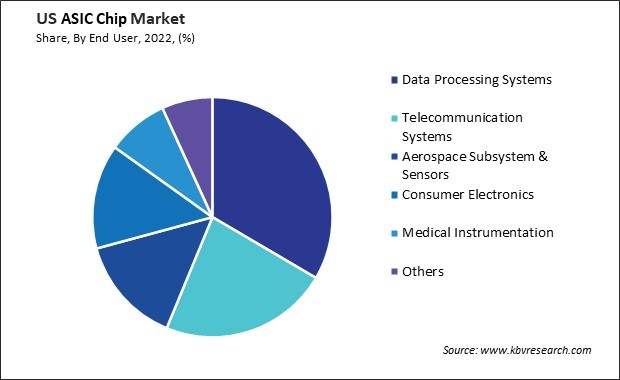Int'l : +1(646) 832-2886 | query@kbvresearch.com
Int'l : +1(646) 832-2886 | query@kbvresearch.com
Published Date : 12-Jul-2024 |
Pages: 89 |
Formats: PDF |
The US ASIC Chip Market size is expected to reach $7.2 billion by 2030, rising at a market growth of 6.7% CAGR during the forecast period.
The ASIC chip market in the United States has grown significantly over the past few decades. One of the key drivers of the ASIC chip market in the U.S. is the growing demand for high-performance computing solutions in sectors such as artificial intelligence (AI) and machine learning (ML). These applications require specialized hardware accelerators to handle complex computational tasks efficiently. As AI and ML continue to permeate various industries, the demand for ASIC chips tailored for these applications is expected to rise.

Furthermore, the proliferation of Internet of Things (IoT) devices in the U.S. fuels demand for ASIC chips optimized for low-power, high-performance operation. These chips are essential for powering IoT devices' sensors, controllers, and communication modules, enabling seamless connectivity and data processing in smart homes, industrial automation, and wearable devices. In addition to technological advancements, the ASIC chip market in the U.S. is also influenced by regulatory factors and industry standards.
Moreover, the telecommunications sector also represents a significant growth opportunity for ASIC vendors in the U.S. as network infrastructure continues to evolve to support emerging technologies such as 5G, edge computing, and cloud services. ASICs play a vital role in enabling the high-speed data processing, packet forwarding, and security functions essential for next-generation networks.
The COVID-19 pandemic has had a mixed impact on the ASIC chip market in the U.S. While the pandemic initially disrupted supply chains and manufacturing operations, leading to temporary shortages and delays, it also accelerated digital transformation initiatives across industries. As businesses and consumers increasingly rely on digital technologies for remote work, e-commerce, and entertainment, the demand for ASIC chips powering these technologies has surged in the U.S.
The automotive industry's rapid expansion in the United States has catalyzed a significant surge in demand for ASIC chips. These semiconductor devices play a critical role in modern vehicles, powering advanced functionalities such as driver-assistance systems, infotainment, autonomous driving features, and vehicle-to-everything (V2X) communication. As automotive manufacturers in the U.S. continue integrating more sophisticated electronic components into their vehicles, the ASIC chip market is experiencing substantial growth.
According to Select USA, in 2020, the United States witnessed a significant boost in its automotive sector, with international automakers manufacturing 5 million vehicles within the country. This surge in production coincided with robust export figures, as the U.S. exported 1.4 million new light vehicles and 108,754 medium and heavy trucks, collectively valued at over $52 billion, to over 200 industries worldwide. This expansion in the automotive industry parallels the growth observed in the U.S. ASIC chip market, reflecting a burgeoning trend in technological innovation and manufacturing prowess across diverse sectors within the nation.
One key driver behind the expansion of ASIC chip usage in the automotive sector is the increasing emphasis on safety and connectivity. Moreover, the proliferation of electric and hybrid vehicles further underscores the importance of ASIC chips in the automotive industry. These vehicles rely heavily on electronic control units (ECUs) to manage power distribution, battery performance, and overall vehicle dynamics. ASIC chips designed specifically for electric vehicles help optimize energy efficiency, enhance battery management systems, and improve overall vehicle performance in the U.S.
In addition to safety and performance enhancements, ASIC chips in the U.S. drive innovation in vehicle connectivity and entertainment. With the advent of connected car technologies, such as in-car Wi-Fi, cloud-based services, and telematics, there is a growing demand for ASICs to support these features while ensuring seamless integration with other onboard systems. Hence, the burgeoning demand for ASIC chips in the U.S. automotive industry reflects a vital convergence of safety, performance, and connectivity requirements.
In the United States, the ASIC chip market is experiencing a significant surge in demand, primarily driven by the ever-increasing need for high-performance computing (HPC) capabilities across various sectors. One of the primary drivers behind the escalating demand for ASIC chips in the U.S. is the rapid expansion of data-intensive technologies such as artificial intelligence (AI), machine learning (ML), big data analytics, and cloud computing. These technologies require robust computing power to process vast amounts of data and execute complex algorithms efficiently.
Additionally, the U.S. government's increased focus on bolstering national security and maintaining technological leadership has increased investments in advanced semiconductor technologies, including ASICs. The defense and aerospace sectors rely heavily on ASICs for mission-critical applications such as signal processing, encryption, radar systems, and surveillance.
Moreover, the thriving ecosystem of semiconductor companies, research institutions, and venture capital firms in the U.S. fosters innovation and drives the development of cutting-edge ASIC designs and manufacturing processes. This ecosystem enables companies to leverage the latest advancements in semiconductor technology to create ASICs that push the boundaries of performance, power efficiency, and reliability. Therefore, the surge in demand for ASIC chips in the U.S. is fueled by the growing need for high-performance computing across sectors, supported by investments in national security and a thriving semiconductor ecosystem.

The ASIC chip market in the United States is dynamic and competitive. One of the leading companies in the U.S. ASIC chip market is Intel Corporation. With its extensive experience and expertise in semiconductor manufacturing, Intel has established itself as a powerhouse in the industry. The company's ASIC offerings include data centers, artificial intelligence, automotive, and networking applications. Intel's advanced fabrication facilities enable the production of high-performance ASICs with superior power efficiency and reliability, making them ideal for demanding workloads in various sectors.
Another major player in the U.S. ASIC chip market is NVIDIA Corporation. Renowned for its graphics processing units (GPUs), NVIDIA has expanded its presence in the ASIC space with specialized solutions for AI, machine learning, and autonomous vehicles. The company's Tensor Core technology, integrated into its ASIC designs, delivers accelerated computing performance for deep learning tasks, enabling AI research and application breakthroughs. NVIDIA's strategic partnerships and focus on innovation continue to drive its growth and influence in the ASIC chip market.
Xilinx Inc. is also a key player in the U.S. ASIC chip market, specializing in field-programmable gate arrays (FPGAs) and adaptive computing solutions. The company's FPGA-based ASICs offer flexibility and reconfigurability, allowing customers to quickly customize their designs and adapt to evolving requirements. Xilinx's portfolio includes high-performance computing platforms, such as the Versal series, which integrate programmable logic, AI engines, and advanced connectivity features. The company's commitment to innovation and customer-centric solutions has cemented its position as a trusted provider of ASIC technologies.
In addition to these industry giants, several other companies contribute significantly to the U.S. ASIC chip market. Qualcomm Incorporated, known for its mobile processors and wireless technologies, has expanded its ASIC offerings to address emerging opportunities in 5G, IoT, and automotive applications. Texas Instruments (TI) is another notable player in the U.S. ASIC chip market, renowned for its analog and mixed-signal solutions. The company's focus on system-level integration and power management enables efficient ASIC solutions tailored to specific use cases, enhancing performance and energy efficiency across diverse applications. With the demand for specialized computing solutions continuing to rise, the U.S. ASIC chip market is poised for further growth and innovation in the years to come.
By Type
By End User